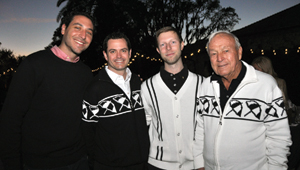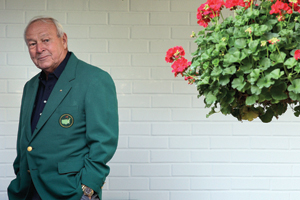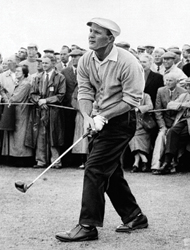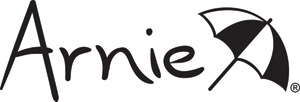From the booth featuring the new line of Arnie golf apparel at the PGA Merchandise Show, designers Geoff Tait and Bobby Pasternak could easily see the banners representing Tommy Hilfiger, Antigua, Under Armour, Cutter & Buck and Greg Norman.
It wasn’t that long ago that Tait and Pasternak were selling their own designs out of the trunk of their car around Toronto. Now they were shoulder to shoulder with some of the giant brands in golf at the sport’s biggest gathering in Orlando.
 |
Arnold Palmer (right) with (from left) Bobby Pasternak, Cori Britt and Geoff Tait show off some apparel from the Arnie line.
Photo by: ARNOLD PALMER ENTERPRISES
|
Tait and Pasternak introduced Arnie apparel at the PGA Show last month, putting a retro twist and a stylish new logo on the venerable Arnold Palmer brand, which was in need of resuscitation.
They call it golf and lifestyle clothing, with shirts, pants and sweaters that replicate Palmer’s look from the 1950s, ’60s and ’70s, when he was considered one of the country’s trendsetters and the game’s iconic figure.
But Arnie’s debut in Orlando represented more than hip, cool clothes and unconventional
designs. (In fact, conventional got thrown out of the window somewhere along International Drive.)
The new collection signifies a completely new direction for an Arnold Palmer brand that was growing tired and losing its relevance. The new direction — engineered by these two Canadian designers and Palmer’s representatives at IMG — is intended to reinvigorate the brand by reaching younger and more diverse consumers with Arnie’s retro look.
In the long-term, Arnie is the first step in breathing new life into the Palmer brand to make sure it’s just as relevant 50 years from now as it was when Palmer still played.
“Up until a few years ago, I don’t think anyone gave it that much thought,” said Cori Britt, vice president of Arnold Palmer Enterprises. “The brand was always successful. But as Mr. Palmer stopped competing (in 2006) and began to move away from the spotlight, internally we started thinking about what we needed to do with the brand to make sure it sustains beyond Mr. Palmer’s lifetime.”
In other words, how do they make sure the Palmer brand is around long after “The King” is gone? The Arnie collection is the first step.
■ ■ ■
For nearly 50 years, Palmer’s brand and his businesses — apparel, golf course design and Arizona Tea — have been represented by the signature of his full name and the four-color umbrella. It’s a classic, conservative look that was suitable for Palmer’s business and the golf shirts that sported the colorful umbrella.
But sales of Palmer’s licensed wear lagged with the last apparel partner and there was a growing sense that the brand’s place in the golf apparel landscape had receded as Palmer, now 82, slipped from his very public life into retirement.
He still made $36 million in 2011 in golf-related income from endorsements and licensing, according to Golf Digest, behind only Tiger Woods and Phil Mickelson, but Britt’s sense was that the brand didn’t have the same energy. And when it came time last year to find a new apparel partner, he didn’t want to repeat the same old licensing deals that had manufacturers slapping a colorful umbrella on a shirt.
“The last apparel contract just wasn’t very successful,” Britt said. “There was nothing distinctive about the product. Anybody can slap a label on a golf shirt. It really made us think, ‘What do we want to do with this brand?’”
Palmer was more than a golf icon in the ’50s, ’60s and ’70s. His brand stood for fashion and lifestyle. He flew airplanes and was one of the first golfers to play all over the world. His swashbuckling, charging style of golf fit those attributes.
 |
His journey from fiery competitor to elder statesman helped Palmer create a long-lasting apparel brand, but the sense was that it was starting to tire.
Photo by: GETTY IMAGES
|
He was also familiar and flexible, the kind of star who could pitch Pennzoil to the blue-collar crowd or Rolex to the high rollers.
As Britt and IMG, which has represented Palmer since his famous handshake agreement with Mark McCormack in 1960, began to think about the brand’s next apparel partner, there was a thought that a nontraditional approach was needed to grab the attention of the North American consumer.
“This was our chance to do something unconventional with an iconic name and brand,” said Jim Neish, vice president of IMG licensing in the Toronto office who made the first outreach to Tait and Pasternak. “This represented a whole new consumer proposition for the younger crowd. Really, the brand had become a little stagnant. We needed to make a significant step change.”
The two designers, who went into business together in 2005 when they formed Quagmire Golf, won the apparel license against competition from several larger companies. IMG said that other companies bid more for the license, but Quagmire “seemed to ‘get it’ more than the others,” Neish said.
They jointly agreed to call the new line Arnie rather than using Palmer’s full name, and they went with a new black-and-white umbrella instead of the more colorful one.
 |
Photo by: AP IMAGES
|
The clothes feature a throwback look that replicates the golf wear Palmer wore in decades when he was most dominant in the performance fabrics of today. The polo shirts will run $75 to $80, sweaters and outerwear around $100, which puts it on a price plane with other high-end golf brands.
They’ve targeted golf clubs and resorts for distribution, as well as golf specialty stores, with an eye on trying to get into a high-end department store, such as Nordstrom.
Ryan Moore, who will wear the clothes on the PGA Tour, represents the thrust of the marketing for Arnie. It’s uncertain if there will be an ad spend on TV or print — none is currently planned — or if the brand will live off social media for its first year.
■ ■ ■
It didn’t take long for Tait and Pasternak to learn the power of the Palmer brand. In the first two hours of the PGA show last month, more people had visited the Arnie booth than the two designers had ever hosted as Quagmire Golf.
“This is incredible,” said Tait, surrounded by cut-outs of Palmer playing golf in the ’60s, an old Ryder Cup golf bag and stacks of the Palmer-licensed Arizona Tea product, all of which added Palmer flair to the booth.
“We used to sit in the Quagmire booth all day and just hope that somebody would stop in,” Tait added. “Now look at this. This really tells you the power of Mr. Palmer’s name.”
It’s a legitimate question to wonder how a pair of young Canadian designers who have specialized in self-described “fun and funky” golf wear wound up with the license to produce Arnie apparel and create the new black and white umbrella logo that will drive the brand into the next 50 years.
The selection of the apparel partner was led by Britt, along with Palmer’s daughter, Amy Saunders, on the Arnold Palmer Enterprises side. IMG’s Alastair Johnston, a longtime Palmer business confidant and manager, and the licensing team collaborated with Britt and Saunders. Neish, who had followed Quagmire’s progress in Toronto and throughout Canada, brought Tait and Pasternak to the table as an alternative option.
“I thought it was a prank phone call,” Tait said of the first call from Neish. “But the more we talked about how we could revamp a brand that was falling off, we saw a clear need for what we could bring.”
The two designers formed Quagmire seven years ago by borrowing money from their parents and selling out of the trunk of their car. In its first year, Quagmire Golf sold $72,000 worth of its colorful golf apparel. A Financial Post story in 2008 reported that Quagmire’s sales were approaching $1 million a year, and sales have doubled annually since.
Tait, who used to teach golf on cruise ships, describes Quagmire as a small-to-mid-sized clothing company that now has product in more than 250 stores.
The from-the-ground-up story resonated with Britt, who knows a thing or two about starting from scratch and working your way up. He first met Palmer when he was 12, caddied for him and eventually worked in all of the Arnold Palmer Enterprises business units before ascending to vice president of the company.
“Those guys just weren’t going to give up and that’s a big part of their story,” Britt said of Quagmire. “They put this together themselves.”
Through its local successes, Quagmire drew the attention of the Jaytex group, a major distributor that also moves Tommy Bahama, Kenneth Cole, Gant and Ben Sherman brands. With Jaytex pushing Quagmire into more mainstream retailers, the efforts of Tait and Pasternak were legitimized and they had the backing to go after a business like Arnie.
Johnston, who has helped manage Palmer’s brand for nearly 40 years at IMG, said, “Arnie’s name has maintained a relevance through many cycles of culture, fashion and taste. This represents something groundbreaking in many ways. Arnie is 82. He’s not retired, but he’s a dormant athlete now,” which changes the game and calls for the kind of adjustment that the Arnie line delivers.
■ ■ ■
When Tait and Pasternak won the license, they visited Palmer’s home in Latrobe, Pa., where they hoped to find some old shirts and sweaters from his playing days. What they discovered was an old barn filled with golf balls, pictures, old licensed products, tractors and golf shoes — a veritable Palmer museum.
“We came across this old cedar chest that was full of old sweaters and cardigans,” said Tait, who took three shirts and a sweater with him back to Toronto for inspiration.
The Arnie line that resulted is targeted for distribution in North America, but the designers were encouraged by the feedback they got from buyers in Europe, making them think that international distribution is a realistic goal. For now, though, Arnie will be sold in the high-end clubs and resorts, such as Doral and Bay Hill, as well as Golfsmith and Golf Galaxy.
Whether the new Arnie marks make their way into other aspects of Palmer’s business remains to be seen. He’s still very strong in Asia, where there are 320 freestanding Arnold Palmer stores, but in some ways the more mature U.S. market has been a little more of a challenge.
“We just didn’t feel like we could continue down the conventional path,” IMG’s Neish said. “Sometimes you have to take two steps back to move forward, and we actually made the very tough decision to remove the brand for 18-24 months while we re-introduced this new concept. Now we have something different, something that will redefine the Arnold Palmer brand.”







